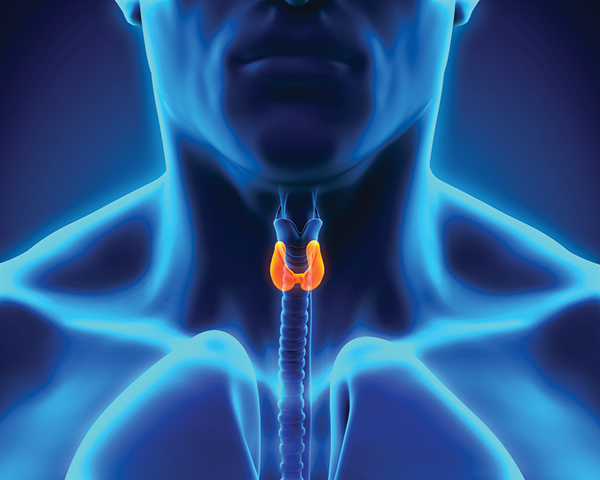A panel of experts has decided that a type of thyroid tumor that poses an extremely low risk of spreading is not a cancer and usually requires less aggressive treatment than previously thought.
The American Cancer Society estimates 64,300 people in the U.S. will be diagnosed with thyroid cancer this year. Papillary thyroid cancer is the most common type of thyroid cancer, accounting for about 80 percent of all thyroid cancers. The reclassified tumor is a subtype of papillary thyroid cancer that will account for an estimated 10,000 to 15,000 of these cases. The subtype contains abnormal cells but is completely surrounded by a capsule that can prevent these abnormal cells from spreading into nearby healthy tissue or blood vessels.

Illustration © iStock / Nerthuz
The subtype was called “noninvasive encapsulated follicular variant of papillary thyroid carcinoma,” or noninvasive EFVPTC. It was treated in many cases like other thyroid cancers: surgery to remove the thyroid gland (thyroidectomy), followed by radioactive iodine treatments to kill any remaining tumor cells. Removing the thyroid meant patients had to take a daily thyroid hormone replacement pill for the rest of their lives.
Yuri Nikiforov, a pathologist at the University of Pittsburgh Medical Center, led the move to reclassify these thyroid tumors. “We knew that this was a very [slow-growing] form of cancer, with a low chance of recurrence, but we didn’t have any solid criteria or data” that could support a change in treatment guidelines, he says. Nikiforov decided to take action after consulting on the case of a 19-year-old patient with noninvasive EFVPTC who was treated with a thyroidectomy. “At that point, I knew I had to do something,” he says.
Nikiforov convened an international panel of 31 experts—pathologists, endocrinologists, a surgeon, a psychiatrist and a thyroid cancer patient advocate—to develop new diagnostic criteria. They analyzed slides and medical records from 268 patients with an EFVPTC tumor. “It became clear to us that when there is no invasive growth, the tumor does not behave as a cancer,” Nikiforov says.
This led the panel to jettison the term “carcinoma” in selecting a new name for the tumor—noninvasive follicular thyroid neoplasm with papillary-like nuclear features (NIFTP), pronounced “nift-p.” The new name will be included in the updated World Health Organization classification of thyroid tumors, to be published in spring 2017.
Patients with a suspected NIFTP are advised to have surgery to remove the tumor and the capsule surrounding it. A pathologist would then carefully examine the capsule to determine if it has any breaks or gaps that would have allowed cancer cells to spread to nearby tissue or blood vessels. If the capsule wall is not intact, it is not a NIFTP and it should be treated as a thyroid cancer.
Bryan McIver, an endocrine oncologist at Moffitt Cancer Center in Tampa, Florida, says the larger the capsule size, the more difficult it is for the pathologist to determine whether the capsule is fully intact. “It might not be practical or possible for a pathologist to examine every last micrometer of a large capsule,” he says. This is why, at Moffitt, a genetic analysis also is performed on the tumor. The types of genetic mutations found inside the tumor, along with the tumor’s size, are used to determine if the complete thyroid needs to be removed, McIver says.
Kathryn Wall, chair of the board of directors for the Thyroid Cancer Survivors’ Association, served as the patient advocate for the panel that developed the new diagnostic criteria. She says there was confusion in the thyroid cancer community after news of the new classification broke. “Some people thought that it included all thyroid cancers, instead of one specific subtype,” she says.
Wall says that although more research still needs to be done on these tumors, she is pleased with the reclassification. “When you hear the word ‘cancer,’ the immediate reaction is to cut it out and be as aggressive as possible,” she says. “If you know it’s not cancer, psychologically it is much easier to deal with.”
Cancer Today magazine is free to cancer patients, survivors and caregivers who live in the U.S. Subscribe here to receive four issues per year.




